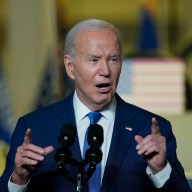GATINEAU, Que. – A CBC proposal for an inexpensive, no-frills TV package of Canadian channels was attacked by Bell TV’s satellite service Tuesday as unworkable and “self-serving.”
The “skinny basic” option was proposed by the public broadcaster on Tuesday as the simplest way to square the demand by conventional broadcasters that cable and satellite firms start paying for their signals, and the carriers’ threat to enact a TV tax on consumers.
During the first two days of hearings on the issue that has divided the industry into warring camps, CRTC chairman Konrad von Finckenstein has said he wants to find a way to help broadcasters without punishing consumers.
CBC president Hubert Lacroix told the Canadian Radio-television and Telecommunications Commission that skinny basic is the answer.
“The simplest and most consumer-friendly approach would be to establish a small, all-Canadian basic service which would include all local television stations and a very limited set of other programming services,” Lacroix said.
Cable and satellite carriers could then charge whatever extra they wanted to for various expanded packages, he said.
But Mirko Bibic, Bell Canada’s head of regulatory affairs, rejected the proposal, saying carriers would lose money on such a package and few Canadians would want it.
And he accused the CBC of acting solely in self-interest since, under the Broadcasting Act, it would have to be part of the package.
“The proponents of skinny basic are self-serving,” he said. “They are saying there’s a value to the CBC signal and if BDUs (cable and satellite firms) don’t agree there is a value, they say, ‘Too bad, you have to carry it.”‘
Bibic went on to say he does not believe the CRTC has a legal right to force the carriers to negotiate on a fee-for-carriage charge.
Commissioner Michel Arpin told Bibic he was wrong about the power of the CRTC. “That’s a decision we think we have a right (to make) and we’ve already made it,” Arpin said.
The exchange once again brought to the fore the contentious nature of the hearings over fee-for-carriage, which conventional broadcasters such as CTV and Global TV say they need just to survive in a 500-channel universe that fragments advertising dollars.
Cable companies, which have become among the most profitable sectors of the industry, have refused to pay for something they say the broadcasters give away for free over the air, and to the Internet.
The situation is somewhat different for Bell TV, which Bibic noted has yet to turn a profit, although it is nearing that point.
In questioning, CRTC commissioners are giving every indication they are leaning to establishing the ground rules for some form of negotiations between the suppliers of television content and the pipeline that distributes it to Canadians.
Noting that the CRTC had foreseen this battle as far back as 1971, commission chairman Konrad von Finckenstein pointed out that the advent of specialty channels had changed the business model of the traditional broadcasters.
“The model was built before we had specialty channels,” he said. “There has been a paradigm shift in the underlying assumptions.”
Von Finckenstein has alternated between frustration and pleading in questioning the players over the refusal of cable and satellite firms to even contemplate any form of bargaining.
In trying to allay fears, he has suggested that any agreement did not have to involve solely a cash transfer. Other considerations might confer value for the signals, he said, including better distribution of specialty channels owned by a broadcaster, or additional opportunities for ad revenues.
He also suggested that fee-for-carriage might only apply to high definition signals.
“We’re all striving for a solution in which Canadians don’t have a higher bill, or if they do, it’s because they are getting a better product,” von Finckenstein said, such as enhanced picture quality.
But Bell TV officials told the CRTC what cable company Rogers Communications had said a day earlier – they already give fair value for the signals by distributing them to 90 per cent of Canadian viewers. That enhances broadcasters’ ability to attract advertisers.
On Monday, Rogers Communications said if it were forced to pay broadcasters for their signals, customers would wind up paying up to $10 a month extra.
The sensitivity of the issue likely means that whatever the CRTC decides, the Conservative government will likely need to weigh in at some point, said media analyst Michael Geist of the University of Ottawa.
“None of the sides want to compromise,” he said.
The CBC’s proposal is an attempt to keep the cost low, and to exempt some Canadians from any increase.
Consumers would be protected from gouging, said Steven Guiton, CBC’s regulatory officer, because the low-cost option would serve as an escape valve for viewers.
“It will temper the marketplace because if rates are going up, (consumers) will have an option. It’s existence alone will help temper prices for all the other services,” he said.
The CBC’s position is similar to that of private sector broadcasters – except unlike CTV – it is not willing to pull its signal in the event it cannot reach agreement on a fee-for-carriage charge.
But Lacroix and other officials laid down similar arguments about why conventional broadcasting, once the linchpin of Canadian television, has hit a wall and needs a change in the rules to continue.
The recession has hurt, he agreed, but over-the-air broadcasters won’t be much better off even when the economy improves.
The CBC tabled a series of charts that showed the downward slide in profitability for conventional television began in the early 1980s, when cable specialty channels began splintering viewership and advertising dollars.
Meanwhile, Lacroix said the industry’s main pipeline – cable – has grown exponentially richer since 1998, when the CRTC deregulated the sector.
















